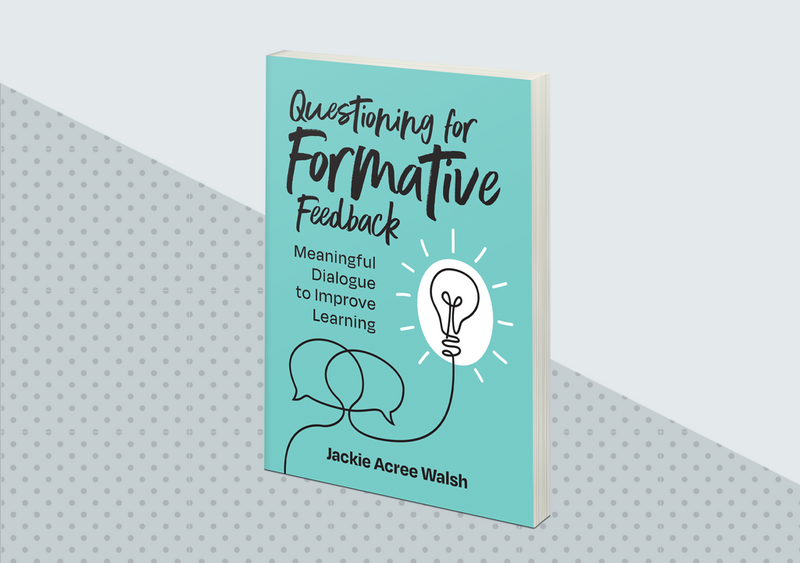The most valuable lessons around giving and receiving feedback—whether to or from students or between colleagues—can be elusive to pin down.
That might be why the late instructional expert Grant Wiggins’s article on seven characteristics of feedback remains one of EL’s most popular articles of all time. In it, he writes that feedback must be goal-referenced, tangible and transparent, actionable, user-friendly, timely, ongoing, and consistent. But what does this type of feedback actually look like in practice?
During ASCD’s @ELMagazine Twitter chat (#ELMagChat) this month, which centered around Educational Leadership’s recent issue on “Feedback for Impact,” participants acknowledged that feedback is tough to master because it “has the potential to lead to real change that raises the stakes,” as Jenn David-Lang puts it. “If it had no impact, then perhaps it would be easier. . .”
With this caveat in mind, authors and educators shared overarching insights they’ve developed around the feedback process.
1) Start with a solid, trusting relationship.
Because receiving feedback makes the receiver feel so vulnerable, the source of that feedback is paramount—meaning that feedback from someone you know, trust, and have a meaningful relationship with is much more likely to work, as Victor Tam shared. Without this, says Alice Oakley, it makes sense why educators might be fearful of feedback—because they “fear the messenger.”
“Feedback can build trust or deplete it, and clarity is a major factor,” writes Ross Romano. “[It] shows you thought deeply about and understood intent and genuinely want to help. The reverse = someone confused about your intentions and with no idea what they're supposed to do.”
Trust is especially crucial to develop when giving and receiving feedback across cultural or racial lines, as EL columnist Jill Harrison-Berg notes: “As a Black woman who grew up in a predominately white community, I had to build my skills for learning from people who don't like me. There are people I don't respect as individuals, but I respect what they know.”
Relationships pave the way for honesty in feedback, a trait missing from Wiggins’s original list that both his daughter Alexis Wiggins and David-Lang mention: It’s about balancing kindness and “cut[ting] through the fluff [to] hear what is useful and real.”
2) Delivery matters.
Much depends on how the feedback is delivered, including whether it expresses clear support and confidence in the receiver’s abilities and clear support, notes Thomas Guskey, as well as transitions that are additive and positive (i.e. "You did this really well. Here is a way that might make it even better!"). Clarity, specificity, and kindness (which, as Romano shares, expresses an offer to help) or keeping critical feedback focused on work and desired outcomes to soften the personal criticism, are also key.
“Constructive criticism often implies, ‘I'm going to be mean, but it's intended to help you get better!’” Guskey writes. “When feedback is accompanied by support for change and confidence in improvement, it seems much easier to accept and use.”
At the same time, niceties can go too far: Tony Frontier has heard from teachers many times that “they don’t want to simply hear ‘nice job’ in evaluative/coaching protocols.” Instead, they want to hear “what’s actually going to help them calibrate and improve?”
When giving feedback to teachers, Jeremy Lubus suggests including a specific, one-sentence impact statement the teacher had on students; for students, Ellen Nabeti uses Project Zero’s Ladder of Feedback, which asks clarifying questions, values what has been done well, states concerns, and then makes suggestions.
And less is always more, writes Myron Dueck: "No one wants 20 pieces of feedback. [O]ne or two key points is better.”
Answering questions like “Where am I going?” “How am I going?” “Where to next?” provides the recipient with, as Jonathan Nipper writes, “‘feed up,’ ‘feed back,’ and ‘feed forward.’ ”
3) Give students ownership over the feedback process.
When it comes to student feedback, teachers should encourage students to own the process. That means setting up a culture where students seek out feedback rather than passively waiting for it, notes Douglas Fisher. To do so, Thomas Guskey recommends “teachers to provide opportunities for feedback and correctives in class,” so teachers can gradually withdraw their support. This requires time for students to put the feedback into action in manageable chunks throughout the learning process, says Toni Martendell, and without grades, says David-Lang.
Paul Richardson compares this to when athletes use feedback after a timeout versus at the end of a game—at which point feedback is more “autopsy data [where] the onus is on the student to apply it next time.” Actionable feedback also means giving multiple attempts to practice in different contexts and having students explain how they used the feedback, “like a team looking at game film before practice,” says Jenny Froehle.
Once students are familiar with the process, they can start to give feedback of their own. Carving out opportunities for students to give peers feedback, notes Nancy Frey, is a process where “they experience both sides of the exchange.”
“My dad once told me, ‘The #1 job of an educator is to find the innate talent inside each student and develop it; be a talent developer,’ ”says Wiggins. “When feedback/choice help a student tap into/explore/grow their interests and talent, everyone wins.”
No one wants 20 pieces of feedback. One or two key points is better.
Myron Dueck
4) Remember that school leaders need feedback, too.
As Jenn David-Lang writes in the April issue, school leaders are often the last ones in the building to get feedback. To solicit feedback from staff, she suggests holding office hours, using online surveys, asking questions via email, and convening focus groups to ask stakeholders for feedback.
Regularly asking for feedback during 1:1 meetings with colleagues “normalizes the intimidating task of giving feedback to a leader,” writes Nancy Frey. Others suggest asking specific questions throughout the year about the real implications of systems and structures on teacher work or using annual anonymous feedback surveys at the end of the year, then summarizing the data in a short paragraph about the reflection it prompted, or digesting the feedback openly with staff.
As principal Victor Tam puts it, “[public feedback is] not always comfortable!” But, “soliciting feedback as a school leader is important for so many reasons.”
5) Practice being a better feedback receiver—but don’t forget the power of your own insights.
Learning how to accept feedback well is a major part of the process, notes Jay McTighe: “Feedback without the chance to use it to make adjustments is like eating without digesting.” And defensiveness to criticism never bodes well.
Modeling how to take and use feedback shows that the school is “a safe space for progress over perfection,” says Romano. While getting negative feedback is “challenging, emotional work,” as Knight admits, you can still practice listening with care and gratitude to learn something—even from incorrect feedback.
This is also true with feedback between teacher and student, which often feels like a one-way street, explains Myron Dueck: “Research suggests that only about 50 percent of students leave school reporting that 'my teachers were willing to learn from me'—we need to change that stat fast!” As Ellen Nabati puts it, “You can ask all the adults in the world, but in the end, the children sitting in front of you are the ones you are teaching. What do they need? How do they need it? When do they need it?”
Alexis Wiggins suggests requesting feedback from students through Google Forms and then sharing the results publicly; if teachers expect students to receive feedback daily, it’s only fair for them to do the same often.
However, it’s also important to keep in mind that feedback on professional practices can be just as—if not more—powerful when people discover insights themselves. “We need to recognize the complexity of teaching and offer anything we share humbly, ”Jim Knight adds, “acknowledging there are no simple solutions to the complex work of teaching.”
Author’s note: Tweets have been edited for length and clarity.
Questioning for Formative Feedback: Meaningful Dialogue to Improve Learning
When used effectively, quality questions and student dialogue result in self-regulated learners and formative feedback that reveals progress toward learning goals.









